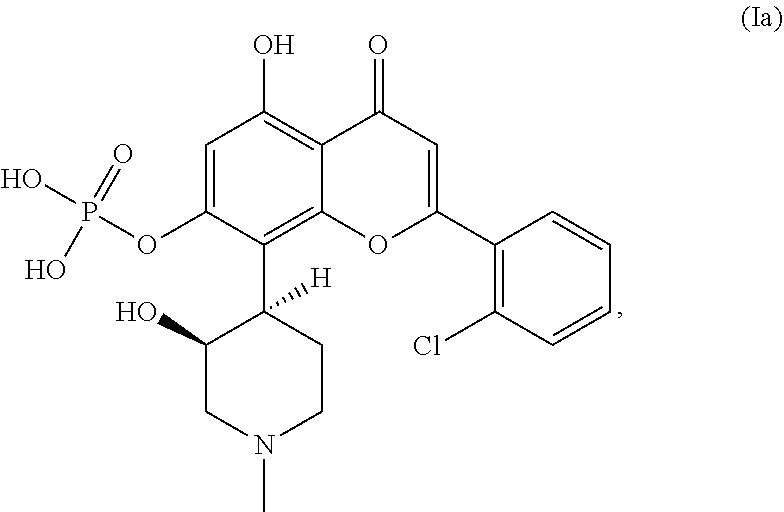Methods for monitoring tumor lysis syndrome
a tumor lysis and tumor technology, applied in the field of tumor lysis syndrome monitoring methods, can solve problems such as severe systemic reactions, and achieve the effect of increasing susceptibility to tls
- Summary
- Abstract
- Description
- Claims
- Application Information
AI Technical Summary
Benefits of technology
Problems solved by technology
Method used
Image
Examples
example 1
, Cytarabine, Mitoxantrone (ACM) Treatment for Patients at High Risk and Not at High Risk for TLS
[0100]Patients receive treatment with ACM over days 1-9 as follows: On days 1, 2 and 3, alvocidib (A) is administered 30 mg / m2 as a 30-minute intravenous (IV) bolus followed by 60 mg / m2 over 4 hours as an IV infusion. Days 4 and 5 are rest days with no chemotherapy treatment given. On days 6, 7 and 8, cytarabine (C) is administered continuously over 72 hours. Dosing of cytarabine is 2 gm / m2 by continuous IV infusion over 72 hours (i.e., 667 mg / m2 daily, for a total of 2 gm / m2). On day 9, mitoxantrone hydrochloride (M) is administered 12 hours after completion of cytarabine treatment at 40 mg / m2 by IV infusion over 1-2 hours.
[0101]Management of Hyperkalemia and Tumor Lysis Syndrome for Patients Receiving ACM Treatment
[0102]Laboratory indicators of tumor lysis syndrome (TLS) are monitored in addition to the therapies listed below. Tumor lysis laboratory evaluations include electrolytes (so...
example 2
for Patients Having Newly Diagnosed AML
[0119]This study will evaluate the safety and efficacy of alvocidib in combination with cytarabine / daunorubicin (7+3) in patients with newly diagnosed AML. Treatment consists of increasing dose levels of alvocidib starting at 20 mg / m2 as a 30-minute IV bolus followed by 30 mg / m2 over 4 hours on days 1-3, cytarabine 100 mg / m2 / day by continuous IV infusion on days 5-11, followed by (e.g., followed about 30 minutes later by) daunorubicin 60 mg / m2 IV on days 5-7. Reinduction therapy with alvocidib (same dose as induction) days 1-3, followed by cytarabine 100 mg / m2 / day continuous IV on days 5-9, and daunorubicin 45 mg / m2 IV days 5-6 is recommended in patients with >10% and >5% cellularity and blasts, respectively.
[0120]TLS Prevention and Treatment
[0121]Mandatory IV hydration with 0.45% NaCl (or similar hydration fluid per institutional standard) sterile solution at 100 cc / hour for at least 10 hours prior to initiation of the first dose of chemothera...
example 3
for Patients Having Relapsed / Refractory AML Following Treatment with Venetoclax Combination Therapies
[0133]This study will evaluate the safety and efficacy of alvocidib in patients with AML who have either relapsed from (i.e., experience reoccurrence of disease following a CR / CRi with duration of greater than or equal to 90 days) or are refractory to (i.e., failed to achieve a CR / CRi, or achieved a CR / CRi with duration of less than 90 days) venetoclax in combination with azacytidine or decitabine.
[0134]Stage 1 of the study is randomized and consists of two arms (26 patients per arm). Those patients in Arm 1 are given alvocidib and low dose cytarabine (LDAC) on a 28-day treatment cycle. On Day 1, patients in Arm 1 are given 25 mg / m2 alvocidib as a 30-60-minute intravenous (IV) bolus. On Days 3 through 12 (10 days), patients in Arm 1 are given 20 mg / m2 cytarabine by subcutaneous (SC) injection each day. On Day 15, patients in Arm 1 are given 50 mg / m2 alvocidib as a 30-60-minute IV bol...
PUM
| Property | Measurement | Unit |
|---|---|---|
| time | aaaaa | aaaaa |
| time variance | aaaaa | aaaaa |
| CRi | aaaaa | aaaaa |
Abstract
Description
Claims
Application Information
 Login to View More
Login to View More - R&D
- Intellectual Property
- Life Sciences
- Materials
- Tech Scout
- Unparalleled Data Quality
- Higher Quality Content
- 60% Fewer Hallucinations
Browse by: Latest US Patents, China's latest patents, Technical Efficacy Thesaurus, Application Domain, Technology Topic, Popular Technical Reports.
© 2025 PatSnap. All rights reserved.Legal|Privacy policy|Modern Slavery Act Transparency Statement|Sitemap|About US| Contact US: help@patsnap.com


